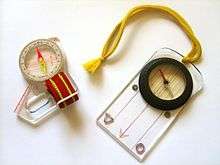Thumb compass

A thumb compass is a type of compass commonly used in orienteering, a sport in which map reading and terrain association are paramount. In cases of homogenous terrain with few distinct features, a bearing between 2 known points on the map may be used. Consequently, most thumb compasses have minimal or no degree markings at all, and are normally used only to take bearings directly from a map, and to orient a map to magnetic north. Thumb compasses are also often transparent so that an orienteer can hold a map in the hand with the compass and see the map through the compass.
Thumb compasses attach to one's thumb using a small elastic band.
The first commercially successful orienteering thumb compass was the Norcompass, introduced by Suunto in 1983.[1]
"The Gear Junkie," a syndicated newspaper columnist in the United States, has an in-depth review of thumb compasses.[2]
Placing an even greater emphasis on speed over accuracy, the wrist compass lacks even a baseplate, consisting solely of a needle capsule strapped to the carpometacarpal joint at the base of the thumb; the thumb serves the function of a baseplate when taking and sighting bearings. It is often used for city and park race orienteering.
See also
External links
- Silva 6 Jet Spectra, a typical modern thumb compass
- The Internet Compass Museum gives comprehensive information about all sorts of compasses and how to use them.
References
| ||||||||||||||||||||||||||||||||||||||||||||||||||||||||||||||||||||||||||||||||||||||||||||||||